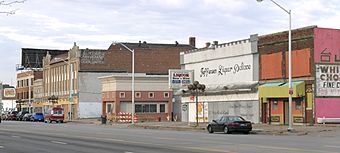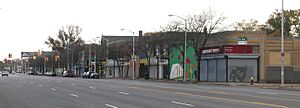Jefferson–Chalmers Historic Business District facts for kids
Quick facts for kids |
|
|
Jefferson–Chalmers Historic Business District
|
|

Jefferson streetscape looking west toward Chalmers in 2008
|
|
| Location | E. Jefferson Ave. between Eastlawn St. and Alter Rd. Detroit, Michigan, U.S. |
|---|---|
| Area | 29 acres (12 ha) |
| Architect | multiple |
| Architectural style | Early Commercial, Late Gothic Revival |
| NRHP reference No. | 04000598 |
| Added to NRHP | June 16, 2004 |
The Jefferson–Chalmers Historic Business District is a cool neighborhood in Detroit, Michigan. You can find it on East Jefferson Avenue, stretching from Eastlawn Street to Alter Road. This area is special because it's the only old shopping district left on East Jefferson Avenue that's still active. It was added to the National Register of Historic Places in 2004, which means it's an important historical spot!
This historic district is one of the few old business areas from the early 1900s that still exists in Detroit. Back in the 1920s, this part of Jefferson Avenue was the main hub for shopping, social events, and culture for the east side of the city. What makes it extra unique are two old ballrooms from the "big-band era" that are still standing: the Monticello and the Vanity Ballroom. These were once super popular places for dancing and fun!
Contents
What's in a Name? Jefferson East
The bigger area around this district is called Jefferson East. It's bordered by Alter Road to the east and St. Jean Street to the west. To the north is Charlevoix Street, and the Detroit River is to the south. Jefferson Avenue runs right through the middle of this neighborhood.
Most of Jefferson Avenue, for about thirteen blocks, is full of shops and businesses. This part is also known as the Jefferson East Business District. The most historic buildings are found along eight blocks of Jefferson Avenue, from Conner to Alter Road. This specific section is what we call the Jefferson–Chalmers Historic Business District.
A Look Back: History of the District
Early Days and Growth
East Jefferson Avenue was originally an old Native American trail. In the 1700s, when French settlers built their farms along the Detroit River, this trail became a road connecting their farms to Fort Detroit. The area where the district now stands used to be a marshy spot around Fox Creek, so not many people lived there at first.
In the 1800s, the Jefferson–Chalmers area slowly became more like farmland as the swamp was drained. In 1851, a special "plank road" was built along Jefferson Avenue. It went from Detroit all the way to Grosse Pointe and even had a toll bridge over Fox Creek. Roadhouses, which were like inns or taverns, started to appear along this road. By 1876, there was a saloon near Fox Creek, right in what is now the historic district.
Building a Community
Serious draining of the swamp began in 1874. A rich Detroit lawyer named William B. Moran owned a lot of the land and helped make this happen. By the 1880s, Moran had built Edgewood Road (now Alter Road) to reach his summer home by the river. In 1891, a streetcar line was built through the district, connecting Detroit and Grosse Pointe.
That same year, the land started to be divided into smaller plots for building. By 1893, many streets crossing Jefferson Avenue were planned out. But by the early 1900s, only a few houses had been built. However, in 1907, the area became part of Detroit. By 1910, many factories were built in the nearby Connor Creek area. This brought a lot of new people to the area, and the Jefferson–Chalmers Historic Business District began to grow very quickly!
Boom Times and Changes
By 1913, many commercial buildings were constructed. One of the oldest buildings still standing is the W.J. Hiller Building, built in 1912. Businesses included tailors, hardware stores, drug stores, and grocers. A small church, St. Columba, was also built.
Just two years later, in 1915, there was a huge building boom! Many new shops and businesses popped up along Jefferson. Car-related businesses also appeared in the late 1910s, along with more churches. Building continued into the 1920s, especially because the Chrysler Motor Company built a huge factory nearby. Many apartments were built to house all the new workers.
The Great Depression (a time of economic hardship in the 1930s) slowed down construction. But businesses started to pick up again later in the 1930s. The Jefferson–Chalmers area did well through the 1940s and 1950s. However, in 1954, the nearby Hudson Motors plant closed. This started a slow decline as jobs were lost and people moved away from Detroit to the suburbs.
New Life for the District
The decline lasted through the 1970s and 1980s. But in the 1990s, people started to invest in the area again. New homes and shops were built.
More recently, the district has seen a comeback! It received a grant from Michigan's Cool Cities Initiative. Millions of dollars were spent on improving the streets, and several important buildings, like the Platte Warehouse and the Chalmers Building, have been fixed up.
Exploring the District: What You'll See
The Jefferson–Chalmers Historic Business District has 57 buildings. They line East Jefferson Avenue for eight blocks, from Eastlawn Street to Alter Road. Alter Road is the border between Detroit and Grosse Pointe Park, Michigan. Most buildings face Jefferson Avenue, but a few are on the side streets near Jefferson.
Most of these buildings are two stories tall and have multiple shops on the ground floor. They were built in the 1910s and 1920s. The district also has apartment buildings and churches. And don't forget the two famous ballrooms: the Vanity and the Monticello! The buildings along Jefferson usually take up the whole plot of land. They are right on the sidewalk and share walls with the buildings next to them, making a continuous line of buildings.
Here are some of the cool buildings you can find:
Churches in the District
- Jefferson Avenue United Methodist Church, 14456 East Jefferson: The original church was built in 1914. It was made bigger in the 1920s with a brick Gothic Revival style auditorium. The original part was taken down in the 1950s, and the auditorium became the main church. A modern addition was built in 1957.
- Faith English Evangelical Lutheran Church, 14554 East Jefferson: This three-story brick and stone church was designed in 1918 and built between 1921 and 1926. It's a unique Neo-Gothic building with a bell tower on one side.
- St. Columba Parish Building, 14635 East Jefferson: This three-story brick and stone building was built in 1923. It has an Elizabethan style with a slate roof. There are shops on the street level.
- Eastminster Presbyterian Church / Original Primitive Baptist Church, 937 Manistique: This Tudor Revival style church was built in 1920. It has a stone front and a strong, castle-like look. The main entrance is a double doorway with an arch.
- St. Columba Episcopal Church, 1021 Manistique: This English Gothic Revival church was built in 1927. It has a cross shape and a large bell tower with a crown-like top. The outside is made of limestone, and it has beautiful stained glass windows.
Apartment Buildings
- Century Lakewood Apartment, 14230-40 East Jefferson: This 3-1/2 story brick apartment building was built in 1924. It's a Classical Revival style building with 44 apartments and seven shops on the ground floor.
- Windmill Pointe Manor, 943 Alter: This four-story apartment building from 1930 has 38 apartments. It mixes Spanish, Moorish, and Art Deco styles, with cool brick patterns and limestone details.
- Pointe Manor Apartments (1020, 1034, 1044, 1060 Alter): These four similar apartment buildings were built between 1925 and 1930. They are 2-1/2 stories tall, made of red and brown brick, and have a Colonial Revival style. They have unique roofs and entrances.
- Eastlawn Apartments, 1044 Eastlawn: This 3-1/2 story Classical Revival apartment building from 1924 has 23 apartments. It has a grand entrance with two columns and projecting sections with copper roofs.
- 950 Manistique: This 2-1/2 story apartment building from 1930 has a Mission/Spanish Colonial Revival style. It's made of dark red brick with a rounded arch on the front.
- IDAO Apartments (910 Marlborough): This 3-1/2 story apartment building from 1927 has Tudor Revival details and is made of red brick.
- Marlboro Apartments (1031 Marlborough): This 3-1/2 story apartment building from 1927 is made of yellow brick with an Elizabethan style.
- Sheldor Apartments (1025 Newport): This 3-1/2 story apartment building from 1925 has 32 apartments. It's made of light-colored brick with a stone base.
Famous Ballrooms
- Vanity Ballroom, 14201 East Jefferson: The Vanity was designed in 1929. It has a cool Mayan/Aztec-inspired Art Deco style. There are shops on the first floor, and the ballroom is above. Look for the brick "jaguars" running across the top of the building and green Pewabic Pottery tiles!
- Monticello Ballroom, 14421-29 East Jefferson: The Monticello is a three-story building from 1928. It mixes Spanish Colonial Revival and Art Deco styles. It has shops on the first floor, and the ballroom was on the second.
Commercial Buildings (Shops and Offices)
- St. Amour Building, 14111 East Jefferson: This two-story brick building from 1920 originally had five shops on the first floor and 13 apartments upstairs.
- Sam's Beauty Supply / S. S. Kresge, 14300 East Jefferson: This single-story brick building from 1936 has a rounded corner and a modern style. It was built by the S. S. Kresge Company.
- W. J. Hiller Building, 14350-56 East Jefferson: This two-story brick building was built in two parts, in 1912 and 1914. It has a diagonal corner and large windows.
- Walgreen's Drugs / Riverfront Building Supply, 14400 East Jefferson: This colorful two-story brick building from 1929 is thought to be designed by Charles N. Agree. It shows off the Art Deco style with colorful brick patterns.
- Platte Apartments / Sutton's Drugs, 14401 East Jefferson: This three-story brick building from 1928 originally had five stores and eighteen apartments.
- Winkelman's, 14411-15 East Jefferson: This two-story brick building from 1928 has a stone look on the second floor with classic columns.
- The Chalmers Building, 14432-36 East Jefferson: This symmetrical three-story brick building was built in 1925. It originally had 33 apartments and four shops. Look for "The Chalmers" carved above the main entrance!
- People's State Bank / National Bank of Detroit, 14555 East Jefferson: This single-story limestone and brick building from 1925 looks like an ancient Greek temple. It has large columns and a fancy top.
- Ned's Auto Supply / Palace Cleaners, 14701 East Jefferson: This low, single-story brick Art Deco building from 1933 has a long roofline and a garage bay. Look for nine plaques with the letter "N" on the roof!
- Fox Creek Backwater Gates, 14737 East Jefferson: This public building from 1930 has a Classical/Art Deco style. It houses underground gates that control the water level of Fox Creek.
- Peter Platte Motor Sales / B. F. Goodrich, 14801 East Jefferson: This three-story brick building was built in 1919 as a showroom for cars. A two-story addition was built in 1936.
Neighborhood Charm: Cityscape
The homes in this area are mostly bungalows and Arts and Crafts style houses. They were built in the early 1900s. Even after many years, these houses still look beautiful and have a lot of character. Most blocks have many houses where the owners live, and the lawns are well-kept. There are some empty lots and a few boarded-up houses that were taken back by banks.
Recently, a company called Shelborne Development finished fixing up three buildings on Jefferson Avenue. They now offer 49 apartments with one, two, or three bedrooms, bringing new life to the area!




